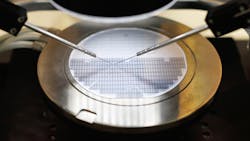Amid Shrinking Sales, the Semiconductor Industry Remains Optimistic
Download this article in PDF format.
After plowing ahead at full throttle throughout much of the COVID pandemic, the global semiconductor market is showing signs of cooling off and returning to a more “normalized” state in 2023. Similar to many industries that rode the massive pandemic “wave” of customer demand (e.g., logistics, transportation, technology, etc.), the semiconductor sector is now facing some of the lowest demand it’s seen in years.
The slowdown started in 2022, according to Gartner, Inc., which points to weakened demand for PCs and smartphones as the key drivers behind the improved supply of chips. The price of computer memory also declined last year.
Tracking a 7.6% Drop in Sales
According to Gartner, the top 10 global original equipment manufacturers (OEMs) decreased their chip spending by 7.6% and accounted for 37.2% of the total market in 2022. It says global inflation and recession pressures sharply weakened demand for PCs and smartphones in 2022, subsequently impacting global OEMs production.
Because most of the top 10 semiconductor customers are major PC and smartphone OEMs, “a sharp drop in consumer demand for PCs and smartphones prevented the top OEMs from increasing unit production and shipments,” said Gartner’s Masatsune Yamaji.
“The zero-COVID policy in China also caused serious material shortages and short-term disruptions to the electronics supply chain,” Yamaji continued. “A lingering semiconductor shortage in the automotive, networking and industrial electronics markets, raised chip average selling prices (ASPs) and accelerated semiconductor revenue increases in these markets.” Combined, these factors resulted in the top OEMs decreasing their share of overall semiconductor spending in 2022 as compared to the prior year.
Accounting for approximately 25% of semiconductor sales in 2022, memory was the worst-performing device category last year, Gartner reports. That particular category experienced a 10% revenue decrease due to dropping prices in the second half of 2022 amid tepid demand. “The top 10 OEMs accounted for 49.2% of memory spend and consequently saw a significant decline in memory spending,” said Yamaji.
A Return to Normal, or Not?
After dealing with a couple of years’ worth of supply chain shortages—some of which were brought on by a lack of chips—the semiconductor industry is experiencing very different market conditions in 2023. “For two years the electronics industry has been impacted, but as device sales slowed in late 2022 and inventory began to recover, it would seem that chip levels have gotten somewhat back to normal,” TechRepublic reports.
Not so fast, the publication warns. While sectors like consumer electronics have experienced an “easing” of the chip shortage—namely due to falling demand that’s driven by the current economic conditions—other sectors may still be dealing with shortages this year. “Consumer electronics is leading the correction downward,” iDEAL Semiconductor’s Mark Granahan told TechRepublic.
The CHIPS Act Kicks Into Gear
Passed into law last year, The CHIPS Act is focused on making the U.S. more competitive with China and relieving some of the supply chain disruptions stemming from Asia. The Semiconductor Industry Association (SIA) and its members are already seeing the positive impacts of the legislation.
As of December 2022, more than 40 new semiconductor ecosystem projects were announced across the U.S., including the construction of new semiconductor manufacturing facilities (fabs), expansions of existing sites and facilities that supply the materials and equipment used in chip manufacturing. According to SIA, nearly $200 billion in private investments was announced across 16 states to increase domestic manufacturing capacity and 40,000 new high-quality jobs have been announced in the semiconductor ecosystem as part of the new projects.
“Companies in the semiconductor ecosystem have responded enthusiastically since the CHIPS Act was introduced, announcing new projects across America totaling hundreds of billions of dollars in private investments and supporting hundreds of thousands of US jobs,” said SIA’s John Neuffer in response to President Biden’s recent State of the Union Address.
More Growth Ahead
Neuffer is confident in the semiconductor market’s strength and resilience going forward. “The global semiconductor market experienced significant ups and downs in 2022, with record-high sales early in the year followed by a cyclical downturn taking hold later in the year,” he said in a press release.
“Despite short-term fluctuations in sales due to market cyclicality and macroeconomic conditions, the long-term outlook for the semiconductor market remains incredibly strong,” he added, “due to the ever-increasing role of chips in making the world smarter, more efficient and better connected.”
About the Author

Bridget McCrea
Contributing Writer | Supply Chain Connect
Bridget McCrea is a freelance writer who covers business and technology for various publications.






